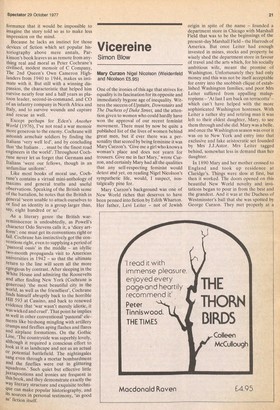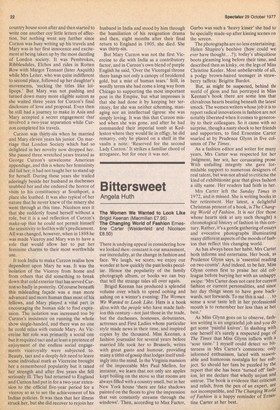Vicereine
Simon Blow
Mary Curzon Nigel Nicolson (Weidenfeld and Nicolson E5.95) One of the ironies of this age that strives for equality is its fascination for its opposite and immediately bygone age of inequality. Witness the success of Upstairs, Downstairs and The Duchess of Duke Street, and the attention given to women who could hardly have won the approval of our recent feminist movement. There must by now be quite a published list of the lives of women behind great men, but if ever there was a personality that scored by being feminine it was Mary Curzon's. 'Give me a girl who knows a woman's place and does not yearn for trousers. Give me in fact Mary,' wrote Curzon, and certainly Mary had all the qualities that any self-respecting feminist would detest and yet, on reading Nigel Nicolson's sympathetic life, would, I suspect, nostalgically pine for.
Mary Curzon's background was one of New World riches that deserves to have been penned into fiction by Edith Wharton. Her father, Levi Leiter — not of Jewish origin in spite of the name — founded a department store in Chicago with Marshall Field that was to be the beginnings of the present-day Marshall Field — the Harrods of America. But once Leiter had enough invested in mines, stocks and property he wisely shed the department store in favour of travel and the arts which, for his socially ambitious wife, meant the promise of Washington. Unfortunately they had only money and this was not be itself acceptable for entry into the snobbish clique of established Washington families, and poor Mrs Leiter suffered from appalling malapropisms — 'At last I am back on terracotta' — which can't have helped with the more sophisticated Washington hostesses. With Leiter a rather shy and retiring man it was left to their eldest daughter, Mary, to see them through and she did. Mary was a belle, and once the Washington season was over it was on to New York and entry into that exclusive and fake aristocratic set founded by Mrs J.J.Astor, Mrs Leiter tagged behind, somewhat less in demand than her daughter.
In 1890 Mary and her mother crossed to England and took up residence at Claridge's. Things were slow at first, but then it worked. The doors opened on this beautiful New World novelty and invitations began to pour in from the best and the grandest. And it was at the Duchess of Westminster's ball that she was spotted by George Curzon. They met properly at a country house soon after and then started to write one another coy little letters of affection, but nothing went any further since Curzon was busy writing up his travels and Mary was in her first innocence and excitement at being taken up by the most dazzling of London society. It was Pembrokes, Ribblesdales, Elchos and rides in Rotten Row with Margot Tennant (later Asquith) while Mrs Leiter, who was quite indifferent to second place, followed up her daughter's movements, 'sucking the titles like lollipops,' But Mary was not pushing and turned down many more eligible suitors as she waited three years for Curzon's final disclosure of love and proposal. Even then he still had a journey to make in Asia and Mary accepted ,a secret engagement that involved a two-year separation while Curzon completed his travels.
Curzon was thirty-six when he married and Mary eleven years his junior. On marriage that London Society which had so delighted in her novelty now dropped her. She passed three wretched years treated as George Curzon's unwelcome American appendage, and this is where her femininity did fail her; it had not taught her to stand up for herself. During these years she trailed adoringly beside her husband as duchesses snubbed her and she endured the horror of visits to his constituency at Southport, a place she loathed. It was also typical of her nature that he never knew of the misery she went through at this time. Nicolson sees it that she suddenly found herself without a role, but it is a sad reflection of Curzon's make-up that he could not permit himself the sensitivity to feel his wife's predicament. All was changed, however, when in 1898 he was made Viceroy and Mary was to have a role that would allow her to put her feminine charms to their most worthwhile use.
It took India to make Curzon realise how dependent upon Mary he was. It was the isolation of the Viceroy from home and from others that did something to break down that cold exterior that has served Curzon so badly in posterity. Of course beneath this misleading facade was a man more advanced and more human than most of his fellows, and Mary played a vital part in encouraging the human side to find expression. The isolation was increased too by Curzon's insistance on running the whole show single-handed, and there was no one he could relax with outside Mary. As Vicereine her role was primarily a social one but it required tact and at least a pretence of enjoyment of the endless social engagements viceroyalty were subjected to. Beauty, tact and a deeply-felt need to leave some individual mark as Vicereine brought her a remembered popularity but it taxed her strength and after five years she fell seriously ill. They had returned to England and Curzon had put in for a two-year extension to the official five-year period for a viceroy so as to see the achievement of his Indian policies. It was then that her illness struck her, but she did recover to rejoin her husband in India and stood by him through the humiliation of his resignation drama and then, eight months after their final return to England in 1905, she died. She was thirty-six.
But Mary Curzon was not the first Vicereine to die with India as a contributory factor, and in Curzon's own blend of purple English he said, 'Over the Viceregal throne there hangs not only a canopy of broidered gold, but a mist of human tears.' Still, in wordly terms she had come a long way from Chicago to supporting the most important post in the Empire, but what impresses is that she had done it by keeping her territory, for she was neither scheming, managing nor an intellectual tigress: she was simply loving. It was this that Curzon missed when she was gone, and after he had commanded their imperial tomb at Kedleston where they would lie in effigy, he did remarry, only he placed on a shelf in the vaults a note: 'Reserved for the second Lady Curzon.' It strikes a familiar chord of arrogance, but for once it was not.



































 Previous page
Previous page